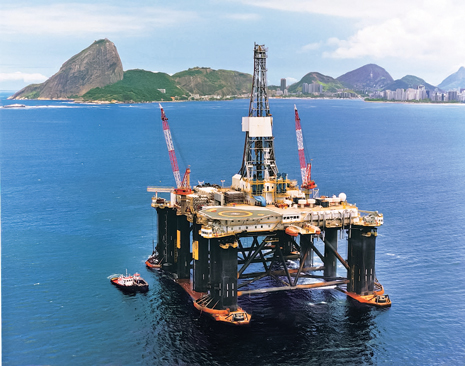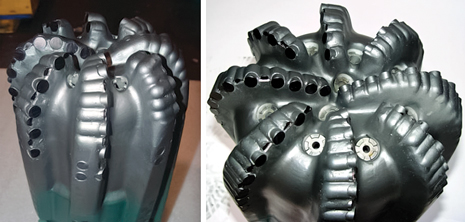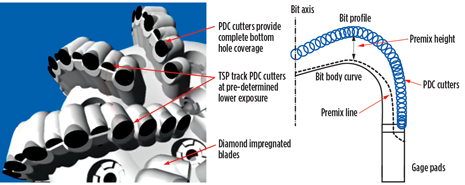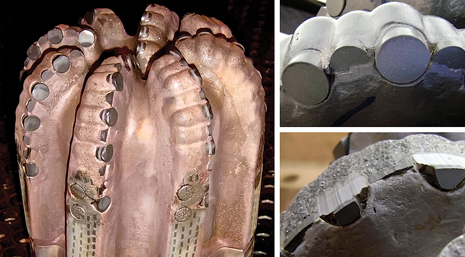SLIM HBAIEB and MICHAEL AZAR, Smith Bits, a Schlumberger Company
 |
| Drilling rig located offshore Brazil (image courtesy of Schlumberger). |
|
Drilling in Brazil’s pre-salt carbonate reservoirs can make bit selection challenging. PDC bits are susceptible to thermal damage, when they encounter abrasive formations, and impregnated bits have a slower rate of penetration (ROP) in soft/medium formations. However, a new hybrid bit has proved capable of ROP and run lengths, similar to a standard PDC bit. The design allows the operator to achieve a long run at high ROP, when no incursions are encountered, and the hybrid’s secondary and tertiary cutting elements enable drilling to continue, when nodules are encountered.
DRILL BIT DESIGN
While designing the new hybrid bit, the service provider had to assess the relative performance of PDC bits, vs. impregnated and roller cone bits, in various formations, under many conditions.
Thermal damage. With continuing advances in synthetic diamond cutter technology and improved bit stability, PDC bits have become a dominant force in the worldwide market. In 2004, total footage drilled by PDC bits (54%) surpassed that of roller cone bits (46%), and the trend has continued. Service providers are working to expand the application range of PDC/diamond bits into harder, more abrasive formations, and into interbedded hole sections. PDC cutting elements are susceptible to thermal damage, when drilling highly abrasive formations, and to impact damage in non-homogeneous formations, and inclusions of chert or pyrite.
Impregnated bit. Conversely, impregnated bits have been restricted mostly to deep intervals that contain mainly hard and abrasive sands. The synthetic and/or natural diamonds used in impregnated bits have good thermal stability and abrasion resistance, which improves bit life and footage drilled compared to conventional PDCs. Diamond size, concentration, distribution, and surrounding matrix can be varied to improve ROP and durability, when drilling through chert/pyrite inclusions or conglomerates with minimal bit vibration. The major drawback to standard impregnated designs is that they generally have much slower ROP than PDC bits in soft/medium formations.
Hybrid bit technology. Furthermore, neither roller cone nor PDC bits have been able to deliver satisfactory penetration rates or bit life when applied to abrasive sandstone interbedded with soft shale. Working with several operators, the service provider conducted extensive tests that resulted in a new hybrid bit technology that incorporates the advantages of both PDC and impregnated bits.1 The new bit (Fig. 1) allows hard/abrasive and interbedded formations to be drilled more economically. The hybrid design has been run successfully in Algeria, the Gulf of Mexico, Brazil, the UK, onshore U.S., Angola and Russia.
 |
| Fig. 1. Innovative hybrid bit design with multiple cutting structures. |
|
Although the bit was initially developed for applications that have a non-to-medium-abrasive top hole section, followed by a very abrasive formation, engineers wanted to test the design in the heterogeneous pre-salt carbonates encountered offshore Brazil, to solve the random occurrence of hard silicate inclusions. PDC bits can drill these carbonates effectively, until the cutting elements are damaged by inclusions. The new style hybrid bit is able to continue drilling with its secondary and tertiary cutting mechanisms after hitting a series of nodules.
CUTTING MECHANISM
The hybrid bit (KH) possesses multiple cutting mechanisms (Fig. 2), combined in a package that includes:
- A PDC cutting structure
- An alternating, wedge-shaped, thermally stable polycrystalline (TSP)
- Multiple blades with diamond impregnated material.
 |
| Fig. 2. Explanation of hybrid bit cutting mechanisms (left) and schematic of fully impregnated blades. |
|
The bit also incorporates high-density diamond impregnated cylinders on gauge, which prevents the bit from suffering due to a reduction in its outer diameter (OD). Extended bit life is achieved through the transformation of the cutting mechanism from shearing to grinding, as the PDC/TSP elements are worn away. When the primary PDC cutting structure is worn down to 50%, the bit still has 75% of life remaining.
The goal is to attain ROP, similar to PDC bits, in the initial formation. The TSP elements engage the formation, after the PDC cutters wear to a certain level. When the PDC and TSP are worn flush to the blade, the cutting mechanism transforms from shearing to a grinding action, Fig. 3. This triple-stacked cutting structure results in a fast initial ROP, with premium PDC cutting elements, and much improved durability with TSP and diamond impregnated portions.
 |
| Fig. 3. Hybrid bit wear patterns showing different levels of cutting structure exposure. |
|
The PDC/TSP cutting structure of the new-style hybrid bits is analyzed through an FEA-based integrated dynamic modeling system, to optimize bit behavior and reduce damaging vibrations.
The bit’s hydraulics consist of nozzles, adding flexibility in adjusting the total flow area. Computational fluid dynamics (CFD)-optimized hydraulics were utilized to optimize the bit’s cleaning characteristics, ensuring efficient cleaning and cooling of the cutting structure.
The bit is equipped with high-abrasion-resistant, premium PDC cutter technology for extended bit life.14-20 These cutters have been tested extensively in the laboratory and show significant improvement to resist abrasive wear, compared to standard premium shearing elements.
The hybrid bit is dull-graded in a manner similar to an impregnated bit, but since the entire blade has usable diamond, initial blade heights are recorded, and final blade heights are measured after the bit run. Using the amount of worn blade/PDC, a 0-to-8 scale is used to calculate its dull grade. Post run measurement should be taken on the same profile section, as on the first measurement. For example, if the initial blade/PDC height is measured at 4.0 cm, and, after running, the final blade/PDC height is 2.0 cm, a final dull grade of 4 is given.
BRAZIL’S PRE-SALT RESERVOIRS
Brazil’s pre-salt carbonate reservoirs represent one of the world’s most important, recent oil discoveries. However, unpredictable bit durability and the ROP need to be addressed for these reservoirs to become commercially viable.
When exiting the evaporate layer, the formation encountered is heterogeneous with varying thickness. Some intervals are PDC-drillable, with ROP up to 6 m/hr and bit runs over 250 m long. Others contain hard, abrasive carbonates; unpredictable occurrences of stromatolitic limestone; microbial laminitis; volcanics; and sporadic silicate inter-layers and nodules.21 These formations have caused multiple trips to change bits, which have suffered heavy damage and worn cutting structures in less than 30 m of drilling.
The heterogeneity and unpredictability of these formations has affected drillability. In particular, the sporadic occurrence of silicate makes the bit-drive selection challenging. Historically, various bit types were tried:
- Roller cones, averaging 100 to 250 m/run, at 1–3 m/hr, resulting in cost/meter higher than $30,000
- Impregnated bits, averaging 400 to 500 m/run, at 1–3 m/hr, resulting in cost/meter of $15,000–$20,000
- PDC runs, varying from 20 to 250 m, at 0.5 to 6 m/hr. Although cost/m for a long PDC run can be lower than $10,000, it can exceed $50,000 for the short PDC runs.
Silicate justified trialing the new hybrid bit offshore Brazil. The bit offers potentially high ROP with the primary PDC cutters. When hard, abrasive inclusions or layers (carbonate with silica content or volcanic formation) are encountered, the TSPs offer superior abrasion resistance. After these cutting elements are worn, the bit transforms into an impregnated bit and will continue to drill.
Several operators have used the hybrid bit to drill over 1,800 m in 12¼-in. hole, and 1,100 m in 81/2-in. hole. From a cost-per-meter (CPM) perspective, when used properly, the hybrid bit offers an average CPM below $20,000, with best runs below $15,000 when the carbonates encountered were more PDC-drillable. The worst runs cost about $25,000, when the PDC structures quickly degraded. Therefore, when planned properly, and mainly for exploratory wells where carbonates are unpredictable and prior knowledge of the formation is reduced, the hybrid solution can lead to fewer trips/non-productive time (NPT), reduced bit spend and a lower cost per meter.
DRIVE SYSTEMS AND PARAMETERS
The hybrid bit was used with various drive systems and parameters to drill the pre-salt carbonates, including:
- A rotary BHA with 140–180 rpm
- Standard-speed motors, with or without a RSS, at 200–250 rpm
- High-speed motors, 600–900 rpm
- Turbines at over 1,000 rpm.
While most runs showed improvement in performance, and have led an operator to adopt this hybrid bit systematically in its pre-salt drilling campaign, a few bit runs did not show performance improvement, due to inappropriate drive system and drilling parameters selection.
Turbine BHA. The hybrid bit was run twice on a high-speed turbine in the 8½-in. hole section. Bit rpm ranged from 1,200 to 1,250. In this case, bit rpm could not be lowered at the start of the run by reducing flowrate, because it would have shut down MWD telemetry. Also, weight on bit (WOB) could not be increased above 15k lb, because the torque generated would stall the turbine. Due to these limiting factors, the PDC/TSP structure did not generate any considerable added value, and performance was comparable to offsets drilled with impregnated bits, in terms of ROP and total footage.
The next hybrid/turbine run drilled 400 m of section, and came out of the hole in good condition and was dull-graded 4-4. Similar results were also obtained when using a hybrid on a high-speed motor, rotating the bit at 700–900 rpm.
Looking at several worldwide applications, PDC cutting structures have delivered good performance on a turbine BHA when drilling homogeneous and non-abrasive formations. However, a PDC bit’s shearing elements suffer low depth-of-cut when run on a high-speed turbine, and an abrasive layer would lead to premature failure of the cutting structure.
Rotating the PDC structure at high rpm is detrimental in these lithologies. Therefore, it would be best to avoid running the hybrid bit on a turbine or high-speed motor in the pre-salt drilling application.
Hybrid on rotary BHA. Two 8½-in. hybrid bits were run on a rotary BHA. One bit drilled over 400 m, while the other was pulled out of the hole (POOH) after only 70 m. An analysis of the drilling data from the 400-m bit run shows that a 5 m/hr rate was achieved for 200 m, using 120–140 rpm with 20 klbs at 375 gpm. When the PDC elements were worn away, and the impregnated structure was engaged, a maximum of 160–180 rpm at 25k lb could be applied, due to top drive limitations. Penetration rate was controlled at an average of 2 m/hr for 200 m. The flowrate was limited to 355 gpm, due to static fluid losses. The bit was dull-graded 8-5.
An analysis of data from the 70-m run shows that WOB started at 25–35k lb, with average rpm of 160-180 and a surface rpm peak of 250, due to stick/slip. Drilling dysfunction exposed the PDC cutting structure to a higher load than on the first run. Flowrate was kept at 355 gpm, due to static fluid losses. The bit was pulled out, due to partial losses, and was dull-graded 8-8 with ring-out marks.
Lessons learned. In an 8-½-in. hole section, the impregnated structure could be cleaned with a relatively low flowrate of approximately 355 gpm, confirming the good hydraulic design. When using a top drive, an rpm range of 160-180 is sufficient to achieve a reasonable 2 m/hr ROP, when drilling with the impregnated structure. However, high levels of stick/slip were experienced when drilling with a rotary BHA, which proved detrimental to the PDC/TSP cutting structure. Reducing the WOB in this case will preserve the cutting structure but could compromise ROP. Although BHA design guidelines can help attenuate damaging downhole dynamics, it is recommended to avoid rotary BHA drilling in this scenario.
Hybrid runs on PDM/RSS. Eleven hybrid bit runs were drilled with a downhole power section:
- Eight 12¼-in. runs on an RSS with a 95/8-in. power section
- Two 12¼-in. runs with a 95/8-in. positive displacement motor
- One 8½-in. run with a 7-in. positive displacement motor
All bits run exceeded 150 m, with four bit runs above 250 m. The penetration rates achieved depended on the formations encountered. One run reached 9.4 m/hr, where the operator encountered a PDC-drillable layer at the top of the hole section. Similar to what was learned from the rotary BHA run, the impregnated structure could achieve good ROP with an rpm range not exceeding 220–250. The positive displacement motor had an advantage, compared to a rotary BHA, because it could achieve higher rpm than the top drive could deliver. If total pressure drop and other well considerations allow, the driller could maximize surface rpm and flowrate, once the impregnated portion of the hybrid bit engages.
When drilling with the impregnated structure, engineers observed that higher WOB was required, compared to a standard turbine/impregnated BHA application. The drilling team surmised this situation is caused by the worn PDC and TSP cutters acting as a bearing surface. However, excessive WOB will lead to a faster impregnated blade wear rate. Therefore, it is recommended to do frequent tests to maximize the bit life in this case.
Unlike turbines, a PDM can efficiently drill with high torque and, therefore, ROP can be enhanced when drilling with the PDC portion of the hybrid bit’s cutting structure. Also, a lower level of stick/slip occurred compared to rotary drilling, preserving the PDC structure. To reduce RPM when drilling with the PDC structure, the driller could reduce surface RPM and eventually the flowrate.
The hybrid design proved valuable when cutting samples were collected at the surface to enhance G&G interpretation and analysis. Even in instances when the impregnated blades were exposed, several PDC cutters remained intact at the bit center and kept producing large drill cuttings. From a G&G perspective, this added significant value compared to turbine applications, when high-quality formation samples were required.
The hybrid bit’s multiple cutting structures proved extremely valuable in the pre-salt application. The combination of PDC/TSP in diamond-impregnated material virtually eliminated lithological uncertainties. In one of the wells, the hybrid bit was run after an eight-bladed 13-mm cutter PDC (M813) was pulled after it drilled just 60 m as follows: 20 m at 7 m/hr; 40 m at 2-3 m/hr. The bit came out dull-graded 4-8. The hybrid bit (KH813) drilled 20 m at 9 m/hr; 90 m at 3 m/hr; and then 200 m at 2 m/hr. The KH bit was pulled after drilling 300 m and was dull-graded 8-8.
A subsequent run with an identical hybrid design encountered an unexpected soft formation and was able to drill 138 m at a fast ROP of 9 m/hr and was pulled at section TD in good, dull condition (2-3). On another well, a six-bladed 16-mm PDC bit (Mi616) drilled just 18 m of formation at 3 m/hr. It was POOH after completing an additional 10 m at 1-2 m/hr. It was pulled for low ROP and was graded 8-8 after less than 30 m. The KH813 hybrid was run in hole (RIH) and made 23 m at an ROP of 2-4 m/hr and then 227 m at 1.5-2 m/hr (DG 7-8). A second hybrid run drilled 315 m at 4 m/hr and was pulled 7-8 at section TD.
CONCLUSIONS
The hybrid bit offers an innovative solution to the geological uncertainties associated with Brazil’s pre-salt play. Using this combination of cutting technologies allows the operator to achieve long bit runs at high ROP, when no silicate inclusion is encountered, and the opportunity to keep drilling ahead at reasonable ROP when/if nodules are encountered. Lower cost/meter can, therefore, be achieved.
Analysis has shown that good, consistent performances were obtained, when the hybrid bit was properly planned and run in a combination with the appropriate downhole power section. Cuttings were also collected for lithology analysis, even when drilling with the impregnated body.
Going forward, efforts will be made to acquire real-time surface and downhole data processing to detect when the impregnated structure is exposed, to appropriately adjust drilling parameters to maximize ROP. Engineers will also strive to improve existing KH hybrid bit designs by continually evolving guidelines for the pre-salt application, to increase drilling efficiency and bit durability. 
ACKNOWLEDGEMENTS
The authors would like to thank management at Schlumberger for permission to publish the bit technologies and run results outlined in this article. The authors would also like to thank João Pedro Tocantins and Erica Zegarra for their contributions. Also, thanks to Craig Fleming, Smith Bits, for his technical writing and editorial contributions.
REFERENCES
1. Azar, M., “Bits and cutting structures,” (U.S. Patent # 7,426,969, September 2008).
2. Aslaksen, H., M. Annand, R. Duncan, A. Fjaere, L. Paez and U. Tran, “Integrated FEA modeling offers system approach to drillstring optimization,” IADC/SPE paper 99018, presented at the IADC/SPE Drilling Conference, Miami, Fla., Feb. 21–23, 2007.
3. Frenzel, M., “Dynamic simulations provide development drilling improvements,” OTC paper 19066, presented at the Offshore Technology Conference, Houston, Texas, Apr. 30–May 3, 2007.
4. Frenzel, M., and B. Kull, “Dynamic balancing of bit/reamer cutters improves drilling performance,” World Oil, p.p. 67-72, March 2008.
5. Algu, D. R, W. Denham, G. Nelson, W. Tang, M. T. Compton, D. F. Courville and D. L. Fitzmorris, “Maximizing hole enlargement while drilling (HEWD) performance with state-of-the-art BHA dynamic analysis program and operation road map,” SPE paper 115607, presented at the SPE Annual Technical Conference and Exhibition, Denver, Colo., Sep. 21-24, 2008.
6. Tellez, C., H. Bedino, O. Casanova, P. Castelazo, S. Wu, J. Mayol, L. Paez, F. Verano and J. Columba, “Application of advanced dynamics modeling significantly improves the stability of rotary steerable drilling with roller reamers, Mexico,” International Petroleum Technology Conference, Doha, Qatar, Dec. 7–9, 2009.
7. Partin, U., M. Compton, G. Nelson, D. Livingston and P. Davis, “Advanced modeling technology: Optimizing bit-reamer interaction leads to performance step-change in hole enlargement while drilling,” IADC/SPE paper 128161, IADC/SPE Drilling Conference and Exhibition, New Orleans, La., Feb. 2-4, 2010.
8. Wu, X., L. Paez, U. Partin and M. Agnihotri, “Decoupling stick-slip and whirl to achieve breakthrough in drilling performance,” IADC/SPE paper 128767, presented at the IADC/SPE Drilling Conference and Exhibition, New Orleans, La., Feb. 2-4, 2010.
9. Barrett, M., M. Compton, M. Agnihotri, F. Verano, S. Mitchell, and D. Fitzmorris, “Dynamic BHA modeling of hole enlargement while drilling lead to ROP improvement in Gulf of Mexico,” OTC paper 20370, presented at the Offshore Technology Conference, Houston, Texas, May 3-6, 2010.
10. Compton, M., F. Verano, G. Nelson and S. X. Wu, “Managing downhole vibrations for hole-enlargement-while-drilling in deepwater environment: A proven approach utilizing drillstring dynamics model,” SPE paper 139234, presented at the Latin American & Caribbean Petroleum Engineering Conference, Lima, Peru, Dec. 1-3, 2010.
11. Vila, P., K. S. Dhaher, G. Miller, M. Machado, P. Strachan, G. Nelson, M. Compton, P. Davis, and S. Wu, “Successful hole enlargement while drilling: Deepwater Brazil,” OTC paper 22637, Offshore Technology Conference, Rio de Janeiro, Brazil, Oct. 4-6, 2011.
12. Wu, X., V. Karuppiah, M. Nagaraj, U. Partin, M. Machado, M. Franco and H. Duvvuru, “Identifying the root cause of drilling vibration and stick-slip enables fit-for-purpose solutions,” IADC/SPE paper 163491, presented at the IADC/SPE Drilling Conference and Exhibition, San Diego, Calf., March 6-8, 2012.
13. Snowie, M., C. Malcolm, G. Alexander, R. Duncan, H. Alemi, I. Jolly and A. Barlow, “Solving swelling clay issues: Modeling effort/concentric reamer saves operator over seven days rig time vs plan, UK North Sea,” SPE paper 158958, SPE Annual Technical Conference and Exhibition, San Antonio, Texas, Oct. 8-10, 2012.
14. Baker, R., Y. Shen, J. Zhang and S. Robertson, “New cutter technology redefining PDC durability standards for directional control: North Texas/Barnett Shale,” IADC/SPE paper 128486, IADC/SPE Drilling Conference and Exhibition, New Orleans, La., Feb. 2-4, 2010.
15. Plemons, B., C. Douglas, Y. Shen, G. Zhan and Y. Zhang, “New cutter technology for faster drilling in hard/abrasive formations,” SPE paper 132143, CPS/SPE International Oil and Gas Conference and Exhibition, Beijing, China, June 8-10, 2010.
16. Murphy, D., N. Tetley, U. Partin and D. Livingston, “Deepwater drilling in both hard and abrasive formations; The challenges of bit optimization,” SPE paper 128295, presented at the North Africa Technical Conference and Exhibition, Cairo, Egypt, Feb. 14-17, 2010.
17. Freeman, M., Y. Shen and Y. Zhang, “Single PDC cutter studies of fluid heat transfer and cutter thermal mortality in drilling fluid,” AADE paper 12-FTCE-38, presented at the AADE National Technical Conference and Exhibition, Houston, Texas, Apr. 10-11, 2012.
18. Gonzales, A., T. Clark, C. Douglas, L. Mueller, J. Yu, J. Shi and Y. Zhang, “Improvements in cutter technology lead to faster drilling in hard abrasive formations, East Texas basin,” SPE/IADC paper 156472, presented at the Middle East Drilling Technology Conference, Muscat, Oman, Oct. 24-26, 2011.
19. Murphy, D., D. Mackay, J. Gilmour, N. Tetley, P. Centala and E. Iwere, “Deepwater drilling in both hard and abrasive formations: The continuing challenge of bit optimization,” SPE paper 151787, presented at the North Africa Technical Conference and Exhibition, Cairo, Egypt, Feb. 20-22, 2012.
20. Zhang, Y., C. Douglas, L. Mueller, Y. Shen and S. Likki, "Refinements to cutter technology and PDC bit hydraulics lead to faster drilling in hard/abrasive formations, East Texas,” IADC/SPE paper 156472, presented at the IADC/SPE Asia Pacific Drilling Technology Conference and Exhibition Tianjin, China, July 9-11, 2012.
21. Peixoto Filho, F.T., and I. S. De Souza Neto, “Brazilian pre-salt: The challenges of coring at a new frontier,” SPE paper 139195, presented at the SPE Latin American and Caribbean Petroleum Engineering Conference, Peru, Dec. 1-3, 2010.
|
The author
SLIM HBAIEB joined Schlumberger in 2002 and has held various positions in field operations, engineering and research. He currently works as an R&D drilling system engineer. Mr. Hbaieb received both his MS degree (1999) and PhD (2002) in control and system engineering from Ecole Supérieure D´Electricite (SUPELEC) in France.
MICHAEL AZAR is a director of Design Engineering for Smith Bits, a Schlumberger company. He joined the company in 1985, specializing in the design and development of PDC and diamond bits. In 1984, he earned his BS degree in mechanical engineering from the State University of New York at Buffalo.
|
|






